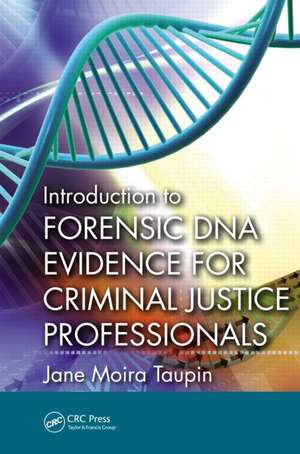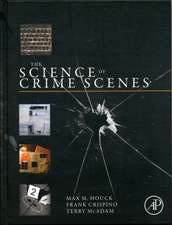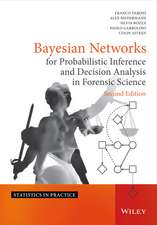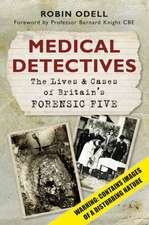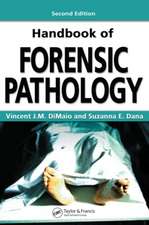Introduction to Forensic DNA Evidence for Criminal Justice Professionals
Autor Jane Moira Taupinen Limba Engleză Paperback – 20 iun 2013
Written by a forensic scientist world renowned for her expertise in clothing examination, the book provides a balanced perspective on the weight of DNA evidence. Going beyond a simple explanation of the methodology, it arms attorneys and other criminal justice professionals with knowledge of the strengths and limitations of the evidence, including the danger in relying on DNA statistical probabilities in the determination of guilt.
The book covers the most common DNA methods used in criminal trials today—nuclear DNA short tandem repeat (STR) techniques, mitochondrial DNA, and Y-STR profiling. It helps prosecutors know when to emphasize DNA evidence or proceed with trial in the absence of such evidence. It assists defense lawyers in knowing when to challenge DNA evidence and perhaps employ an independent expert, when to focus elsewhere, or when to secure the advantage of an early guilty plea.
By imparting practical and theoretical knowledge in an accessible manner, the book demystifies the topic to help both sides of the adversarial system understand where DNA evidence fits within the context of the case.
Preț: 484.40 lei
Preț vechi: 569.88 lei
-15% Nou
Puncte Express: 727
Preț estimativ în valută:
92.69€ • 97.03$ • 76.69£
92.69€ • 97.03$ • 76.69£
Carte tipărită la comandă
Livrare economică 07-21 aprilie
Preluare comenzi: 021 569.72.76
Specificații
ISBN-13: 9781439899090
ISBN-10: 1439899096
Pagini: 192
Ilustrații: 11 black & white illustrations, 2 black & white tables
Dimensiuni: 152 x 229 x 13 mm
Greutate: 0.32 kg
Ediția:New.
Editura: Taylor & Francis
Colecția CRC Press
Locul publicării:Oxford, United Kingdom
ISBN-10: 1439899096
Pagini: 192
Ilustrații: 11 black & white illustrations, 2 black & white tables
Dimensiuni: 152 x 229 x 13 mm
Greutate: 0.32 kg
Ediția:New.
Editura: Taylor & Francis
Colecția CRC Press
Locul publicării:Oxford, United Kingdom
Public țintă
Academic and Professional Practice & DevelopmentRecenzii
. . . a valuable introduction, with many useful examples. The limitations of the subject, the need for caution in interpretation and problems such as contamination and degradation are expertly handled.
—Graham Fricke, QC, retired County Court Judge
Overall this book is very clearly written. The author is able to simplify complex scientific terms and concepts into information understandable by a wide audience with divers experiences and backgrounds … This book will serve as a great reference for nonscientists who routinely encounter DNA evidence within the criminal justice system and for students interested in an introduction to forensic DNA evidence.
—Book review by Krista E. Latham, PhD, appearing in the Journal of Forensic Sciences, July 2014, Vol. 59, No. 4
—Graham Fricke, QC, retired County Court Judge
Overall this book is very clearly written. The author is able to simplify complex scientific terms and concepts into information understandable by a wide audience with divers experiences and backgrounds … This book will serve as a great reference for nonscientists who routinely encounter DNA evidence within the criminal justice system and for students interested in an introduction to forensic DNA evidence.
—Book review by Krista E. Latham, PhD, appearing in the Journal of Forensic Sciences, July 2014, Vol. 59, No. 4
Cuprins
Acknowledgment, About the author, 1 History of forensic DNA profiling in criminal investigations, 2 Strengths and limitations of DNA profiling evidence, 3 DNA profiling basics, 4 Evidential value and statistics, 5 Partial profiles, low levels, and mixtures, 6 Y-STR profiling, 7 Other DNA techniques including mitochondrial DNA, 8 Concerns and controversies, 9 DNA pointers for criminal justice professionals, Appendix A: Glossary of terms used in reports and testimony, Appendix B: Selected DNA issues and case examples, Appendix C: Steps in review of evidence
Descriere
The use of DNA profiling in forensic cases has been considered the most innovative technique in forensic science since fingerprinting. This volume is designed for nonscientific readers who need to learn how to effectively use forensic DNA in criminal cases. Topics include nuclear DNA short tandem repeat (STR) techniques, mitochondrial DNA, and Y-STR profiling. By imparting practical and theoretical knowledge in an accessible manner, the book demystifies the topic to help both sides of the adversarial system understand where DNA evidence fits within the context of the case.
